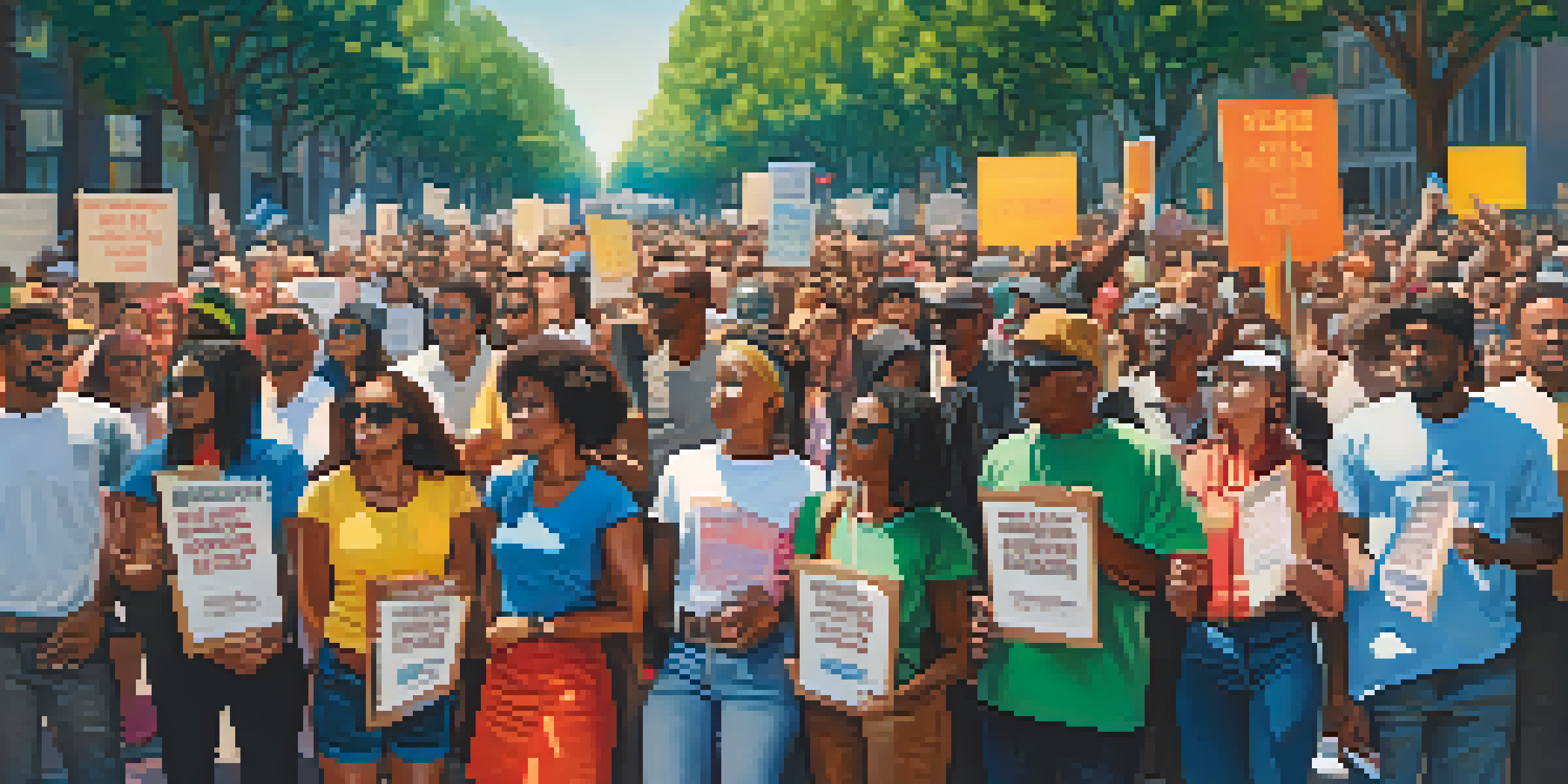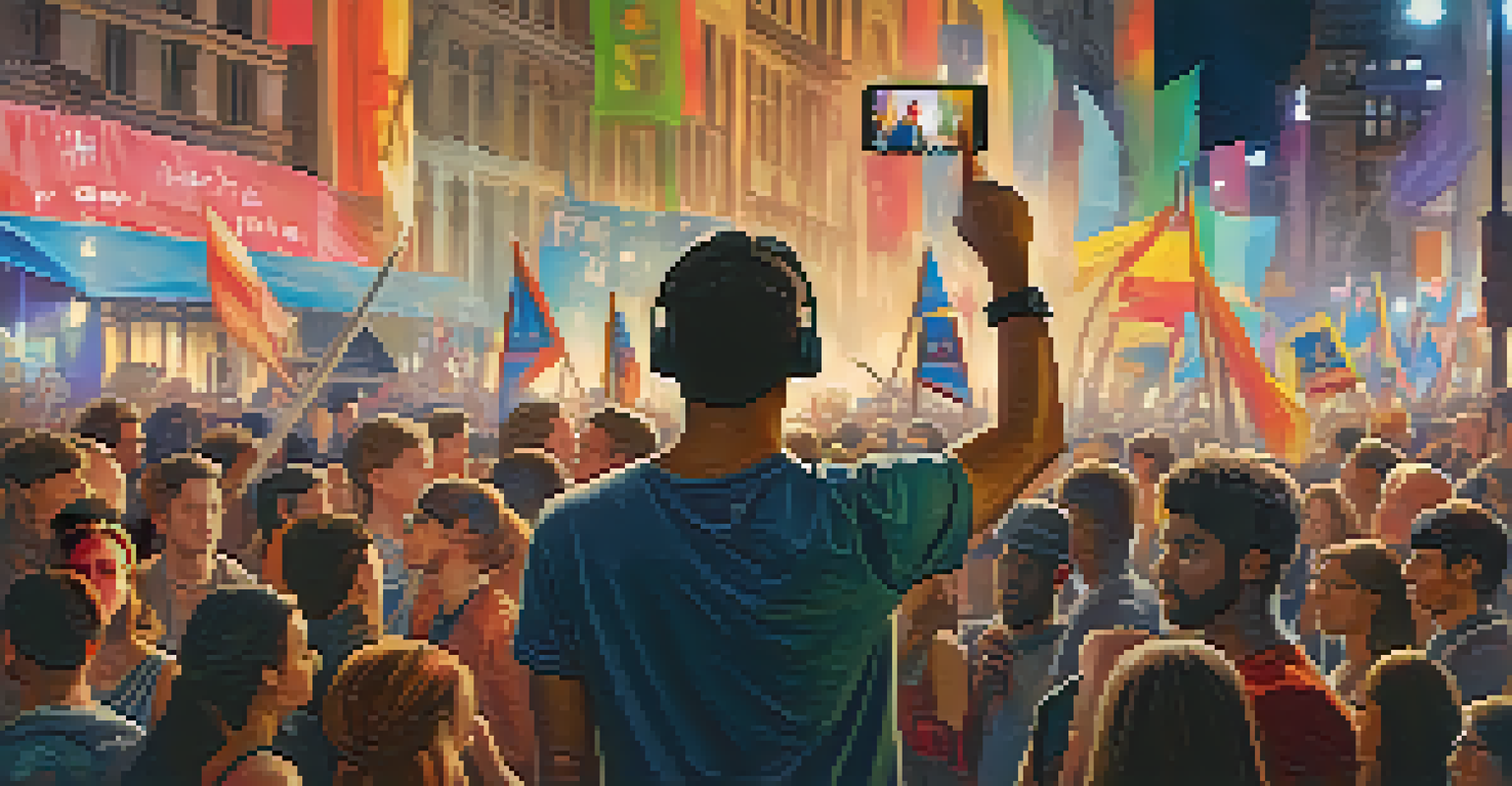Using Technology for Personal Safety During Protests

Understanding the Role of Technology in Protests
In recent years, technology has transformed how protests are organized and experienced. From social media platforms to mobile apps, activists can now communicate and mobilize supporters in real time. This shift has not only increased participation but also raised the stakes for personal safety during these events.
Technology is a double-edged sword. It can be used as a tool for liberation or a weapon for oppression.
The integration of technology allows protesters to share information quickly, such as locations of gatherings or updates on law enforcement activity. However, with this convenience comes the necessity to remain vigilant about personal safety. Understanding how to use technology effectively can empower individuals during protests.
As we navigate this digital landscape, it's crucial to recognize both the benefits and the potential risks. For instance, while live-streaming can document events, it can also expose individuals to unwanted attention. Therefore, leveraging technology wisely is key to enhancing personal safety while advocating for change.
Essential Apps for Protest Safety and Communication
Several apps have emerged specifically designed to enhance safety during protests. For example, apps like Signal or WhatsApp allow for encrypted messaging, ensuring that communications remain private even in tense situations. This can be particularly crucial when coordinating with others or reporting incidents.

Additionally, safety apps such as 'Breeze' can provide real-time location sharing with trusted contacts. This feature allows friends or family to monitor your whereabouts, giving them peace of mind as you participate in a protest. Leveraging these tools can help create a support network around you.
Tech Enhances Protest Organization
Technology like social media and apps empowers activists to mobilize and communicate effectively during protests.
It's important to familiarize yourself with these apps before attending a protest. Knowing how to navigate these tools can save valuable time in an emergency. As you prepare, consider downloading a few safety apps that resonate with your needs and comfort level.
Using Social Media to Stay Informed
Social media platforms are invaluable for staying updated during protests. They provide real-time information on crowd sizes, the presence of law enforcement, and even potential hazardous situations. Following trusted sources and local activists can help you stay informed and prepared.
In the age of information, ignorance is a choice. Stay informed, stay engaged, and stay safe.
However, it’s essential to curate your social media feeds wisely. Following accounts that prioritize accurate information can prevent the spread of misinformation, which is particularly rampant during protests. This way, you can focus on reliable updates that keep you safe and aware.
Additionally, consider using social media to share your own experiences and observations. This can help inform others and create a community dialogue. Just be cautious about what you post, as sharing certain details can inadvertently compromise your safety or that of others.
The Importance of Battery Life and Connectivity
When attending a protest, ensuring your device has sufficient battery life is crucial. Protests can be long and unpredictable, and you don’t want to find yourself without a way to communicate. Carrying a portable charger can be a game-changer in maintaining connectivity throughout the day.
In addition to battery life, consider your data connectivity. Being in a crowded area can sometimes lead to network congestion, making it difficult to access essential apps. Having offline maps or downloaded resources can help navigate without relying solely on your phone's connectivity.
Safety Apps are Essential Tools
Using apps for encrypted messaging and location sharing can significantly enhance personal safety for protesters.
Staying connected also means preparing for potential disruptions. Some protests may see an intentional blackout of cell service by authorities. In such cases, having backup plans, like designated meeting spots or written contacts, can help ensure your safety.
Creating a Safety Plan with Friends
Before heading to a protest, it’s wise to create a safety plan with your friends or fellow protesters. Discuss meeting points in case you get separated and establish a communication method for keeping in touch. Having a solid plan can alleviate anxiety and enhance your collective safety.
Consider designating a 'safety buddy' who will check in with you regularly throughout the event. This person can help keep you aware of any potential dangers and ensure that you maintain a safe distance from trouble. A buddy system can be a crucial layer of protection.
Moreover, sharing your plan with someone outside the protest can add an extra level of security. Informing a family member or friend about your whereabouts and the details of your plan ensures that someone is aware of your actions and can assist if needed.
Recognizing Signs of Trouble and Responding
Being aware of your surroundings is essential for personal safety during protests. Look for signs of escalating tension or potential trouble, such as aggressive behavior from law enforcement or confrontations among protesters. Recognizing these cues early can help you navigate safely.
If you sense that the situation is becoming dangerous, it’s vital to have an exit strategy. Knowing the quickest and safest routes out of the area can help you avoid potential conflict. Having a plan in place can make all the difference when you need to leave quickly.
Know Your Rights When Protesting
Understanding your legal rights during protests is crucial for navigating interactions with law enforcement confidently.
Additionally, trust your instincts. If something feels off, don't hesitate to take action to protect yourself. Whether that means moving away from a crowd or seeking assistance, prioritizing your safety should always come first.
Understanding Your Rights During Protests
Educating yourself about your rights as a protester is crucial for personal safety. Familiarize yourself with local laws regarding protests, including your rights regarding arrest and interaction with law enforcement. Knowing your legal standing can empower you to navigate protests more confidently.
Many organizations provide resources that outline these rights, often in simple, accessible language. Carrying a printed copy of your rights can serve as a useful reminder during a protest. This can also help you communicate effectively with law enforcement if necessary.

Understanding your rights helps you advocate for yourself and others effectively. It can provide reassurance in tense situations, allowing you to focus on your message rather than fear of repercussions.